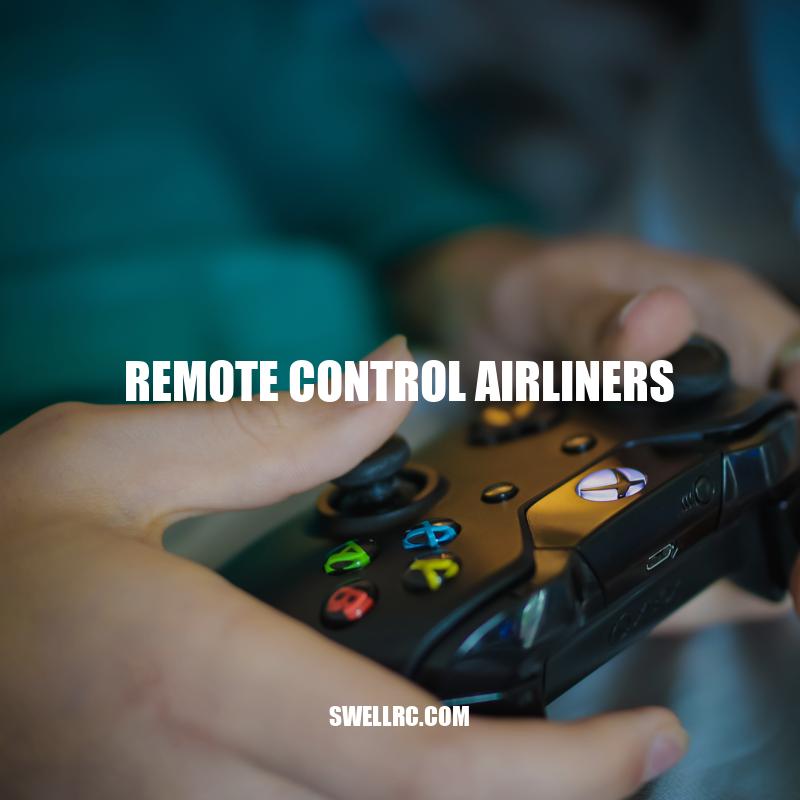Remote Control Airliners: Types, Benefits, and Tips.
Remote control airliners, also referred to as RC planes, are miniature aircraft operated from a distance by a plane controller. These models mimic the movements and capabilities of real-life airplanes, including commercial airliners, military planes, and jets. Although remote control airliners have been around for several decades, recent innovations in technology have significantly advanced their capabilities, and they have now become a popular hobby for enthusiasts and professionals alike. The planes come in a broad range of sizes, from small, simple models to complex, high-performance aircraft. With options such as gliders, trainers, warbirds, and scale models, remote control airliners provide a wide variety of choices to meet the interests and skill levels of users. Flying remote control airliners can also offer a platform for creativity, learning, and education, particularly for young people interested in science, engineering, and aviation. Whether flown competitively or recreationally, remote control airliners provide a unique blend of technical skill and fun that can be enjoyed by anyone interested in the thrill of flight.
Types of Remote Control Airliners
There is a vast number of remote control airliners available on the market with varying features and capabilities. Some general types of remote control airliners include:
- Trainers: These are perfect for beginners who are just starting on remote control planes. They are durable, easy to assemble and are usually equipped with self-stabilizing features, making them easier to fly.
- Sport Planes: These planes are built for aerobatics and high-performance flying, making it ideal for hobbyists who enjoy stunts and tricks.
- Scale Models: These planes replicate the design and structure of real-life aircraft and are generally used for display and demonstration purposes.
- Warbirds: These planes are replicas of World War II aircraft and require some expertise in piloting, making it more suitable for advanced users.
- Gliders: These planes rely on wind and thermals for power and have the capability to fly for long periods without the use of fuel or motors.
Each type of remote control aircraft has its unique set of characteristics and challenges, and the choice of the plan depends on the experience level, skill, and personal preference of the user. Websites such as Horizon Hobby and Tower Hobbies offer a broad range of remote control airliners of different types and models to suit various requirements.
What are remote control airplanes used for?
Remote control airplanes are commonly used for recreational purposes, such as flying them as a hobby. However, remote control airplanes are also used for scientific, government, and military purposes. Scientific organizations use them for experiments, gathering weather readings, aerodynamic modeling, and testing. A wide variety of models, parts, and styles is available for the DIY market. You can find more information about remote control airplanes on various websites like horizonhobby.com, rcgroups.com, and towerhobbies.com.
Remote control airliners can be both rewarding and challenging to fly, they require skill, precision, and knowledge to operate. Some tips and tricks for building and flying remote control airliners include:
- Choose the right materials: The choice of materials used in building remote control airliners is critical as it affects the overall durability and performance of the plane. Balsa, plastic, foam, and carbon fiber are some commonly used materials.
- Follow instructions carefully: This step is important to follow as it’s necessary for safe and effective building.
- Take safety precautions: Always wear protective gear when building remote control airliners, like safety glasses and gloves.
- Ensure proper balance: For the best performance, the center of gravity of the plane must be correctly adjusted.
- Test-flight: Before flying the remote control airliner, test fly it indoors or outdoors in an open area to make sure everything is working as planned.
- Flying precautions: Always make sure the batteries are fully charged, check the weather, and fly at a safe distance from people, trees, and buildings. It is also important to know your battery’s capacity and voltage as it affects the flight time and the performance of the remote control airliner.
A remote control airliner’s performance and stability are dependent on its aerodynamic design and layout. Understanding this requires mathematical calculations that include comparing thrust, drag, and airframe weight to ensure the optimal flight characteristics. The remote control airliner is also constructed based on the type of wing structure it will have. A monoplane and biplane design differ in wing construction, which is the determining factor that provides the remote control airliner’s flight characteristics.
Websites such as Flite Test and RC Planet offer remote control airliner pre-built kits, components, and accessories that make it easier to construct and customize the remote control airliner to desired performance. Below is a table of components and accessories required for remote control airliner construction:
| Component/Accessory | Description |
|---|---|
| Transmitter and Receiver | Allows for two-way communication between the operator and the remote control airliner to activate or shut down the plane. |
| Electronic Speed Controller | Regulates the speed of the motor during the remote control airliner’s flight operation. |
| Battery | Provides power to the remote control airliner’s motor and other electronic systems. |
| Servo | Responsible for aircraft movement, such as controlling the rudder, elevator, and ailerons. |
| Propeller | Converts electric motor power to thrust for flight operations. |
| Charger | Used to charge the battery before flying the remote control airliner. |
How does a remote control plane fly?
A remote control plane flies with the help of a ground operator using a hand-held transmitter. The operator communicates with an electronic receiver inside the aircraft which then sends signals to move the mechanisms that change the position of the plane. Radio control is used to remotely control a device and is commonly used in garage door openers and keyless entry systems for vehicles. (Source: Wikipedia)
Benefits of Remote Control Airliners
Remote control airliners have numerous benefits for both individuals and children alike. Some of the benefits of remote control airliners include:
- Improved Hand-Eye Coordination: Beginners benefit from flying remote control airliners to improve hand-eye coordination and become skilled in controlling movements at a safe distance.
- Learn About Aviation: Remote control airliners help people to understand aircraft mechanics, physics, and mathematics in a fun and interactive way. This can be a great educational experience for younger people, as they learn about engineering, aerodynamics, and programming principles.
- Economic: The cost of flight systems and model building components has reduced significantly, making remote control airliners a cost-effective extracurricular activity.
- Bonding Experience: Building and operating remote control airliners is an exciting hobby that can be enjoyed by the family, friends, and communities.
- Proven Stress Buster: Flying remote control airliners is often cited as a stress-relieving hobby that promotes mental peace and relaxation.
Remote control airliners can be customized to desired performance and style requirements. A great place to start remote control airliner customization is to acquire pre-built kits. Websites like Horizon Hobby, AMain Hobbies, and Tower Hobbies sell pre-built models and offer customization services to ensure that remote control airliner enthusiasts have the ideal high-performance remote control airliner experience. These sites are popular with beginners and experienced enthusiasts for their customer service, part availability, and delivery speed.
Below is a table of websites that sell remote control airliner pre-built kits, and the benefits of purchasing from each website:
| Website | Benefits |
|---|---|
| Horizon Hobby | Large inventory of high-quality remote control airliner kits, available customer service, and consideration for safe delivery of goods. |
| Tower Hobbies | Expert advice, wide range of selection available to customers, live chat and a rewards program with a gift certificate for every purchase made. |
| AMain Hobbies | Well rounded with many RC hobbies materials available for sale, famously available for fast shipping with many payment options. |
What are the advantages of RC planes?
Flying RC planes and building them have numerous advantages. It is a fun and rewarding hobby that provides a sense of relaxation while also teaching valuable skills like patience, attention to detail, and problem-solving. Additionally, RC planes allow enthusiasts to fly like a real pilot, performing aerobatic and acrobatic maneuvers without leaving the ground. Flying RC planes can be enjoyed alone or with friends, providing a sense of community among enthusiasts. For those interested in purchasing RC planes, hobby shops and online stores like Horizon Hobby and Tower Hobbies offer a wide range of options to fit any skill level or budget.
Conclusion
Remote control airliners have become increasingly popular for enthusiasts and hobbyists who enjoy exploring the skies from the ground up. With their cost-effectiveness, educational benefits, and customizable features, they provide an exciting and fun way to build new skills and foster lifelong learning. Enthusiasts can find new and constantly evolving remote control airliner models to meet their needs on websites such as Horizon Hobby, Tower Hobbies, and AMain Hobbies. With the broad range of benefits and options offered, remote control airliners are unquestionably sure to remain a popular hobby that can challenge and excite both beginners and veterans alike.



